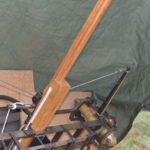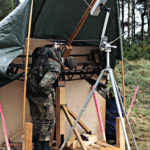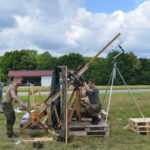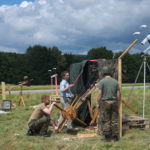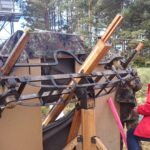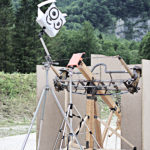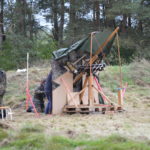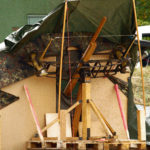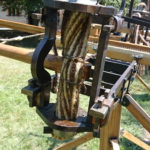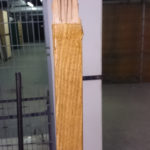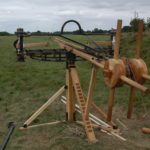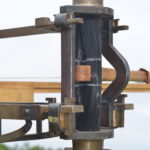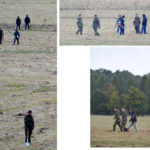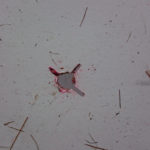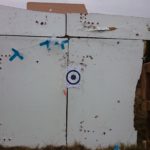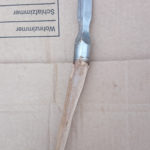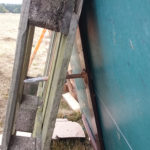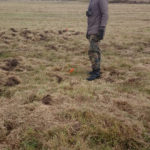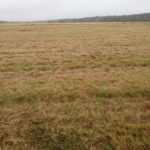- Our catapult springs (made from oiled animal fibres) and arms (made from ash wood, horn and iron)
- Range testing at 45 degrees elevation using a shooting chronograph; the building around the catapult is for rain and damage protection. As yet, we have obtained consistent speeds of 281 fps (86 m/sec.) and distances of more than 550 m (601.5 yards) [largest: 556m (608 yards), reached several times at Ramsau-Molln training ground in Austria on 27th June, 2017] using elastic Ps.-Heron type arms (which consist of ash wood, buffalo horn and iron and work like composite bow arms), drawing the arms up to 86 degrees. After each shot, the catapult is meticulously inspected for damages, wear and tear.
- Trier, July 2016: Range testing with differently interpreted Ps.-Heron arms (stiff rather than flexible). With these stiff arms, we reached up to 504 m (551 yards) at speeds up to 256 fps (78 m/sec.). However, these arms broke at higher tension, due to a building mistake. In the background, you see the scorpio (Teruel type) which the Trier colleagues built for their tests
- Trier, July 2016: Range testing using shooting chronograph.
- Range testing with non-elastic Ps.-Heron arms at Munster
- Ramsau-Molln 2017: new ballista with improved winch and stiff (non-elastic) Ps.-Heron arms, optical and Doppler-Radar speed measurement units and protective shielding for the ballista team. With this arrangement, we reached 556m, in spite of the heavy weight arms
- Drawing the slider and the elastic arms back
- The ballista with its arms and springs exposed
- The ballista equipped with simple ash wood arms and springs made from oiled horse hair
- Arms made entirely of wood (ash wood) do not stand the stress exerted upon them by more refined springs made from oil-impregnated animal fibres.
- Test firing the ballista with horse hair springs
- Test firing the ballista with polyamide (Nylon) ropes as springs; ordinary Nylon (poyamide) is not elastic enough for an inswinging ballista with its inherently large requirements in terms of spring cord elongation.
- The ballista equipped with simple ash wood arms and springs made from polyamide [Perlon(R)] monofile strings.
- Test firing the ballista with Perlon(R) springs; the Performance of Perlon monofile is comparable to horse hair.
- Recovering arrows and measuring distances: Our tests imply much long-distance driving and walking over meadows, the use of spades to dig out arrows and laser range finders to measure shooting distances. We have been using different types of arms and arrows, different kinds of oiled animal fibres for the springs and different angles for shooting between 5 and 45 degrees. For all these we have obtained measurements for draw forces, draw lengths/draw angles, missile speeds, shooting distances and shooting deviations. After 4 years of extensive using and improving two kinds of scorpiones and two types of ballistae, we will publish the results, probably next year.
- Typical mark left by arrow in chipboard panel (table tennis plate; note the remains of a wooden tailwing stuck in the hole)
- Chipboard panel with several marks left by shots through target
- Arrow head of arrow shot on SK IV ceramic plate
- Penetration force: This arrow has a flattened tip (produced mechanically by abrasure) with a surface of 1×1 cm; at a distance of 120m, it penetrated the 25mm chipboard, a 15mm oak beam, the upper 15mm beam of a Euro-pallet only to be stopped by the latter’s lower beam.
- Precision 1: Arrows which are shot with the same draw length and angle are found very close to each other (a few decimetres length and very little width deviation at ca. 480m)
- Precision 2: Arrows come down closely grouped and neatly distinguished according to draw lengths
- Precision 3: Arrow cluster in the Niklbach river bed at Ramsau-Molln training ground
Letzte Änderung: 20. März 2018
